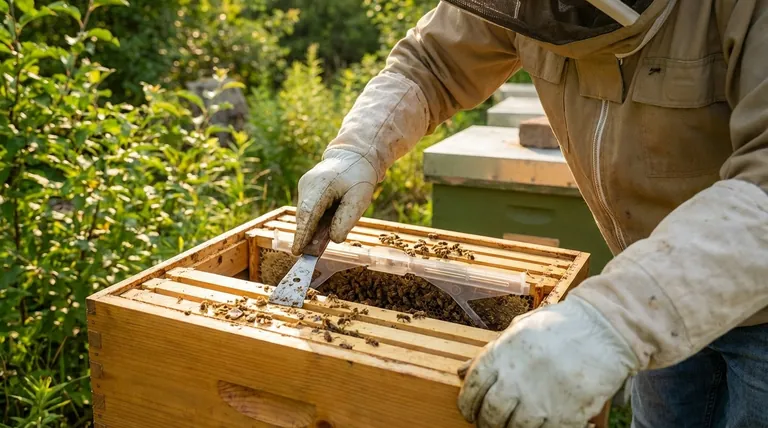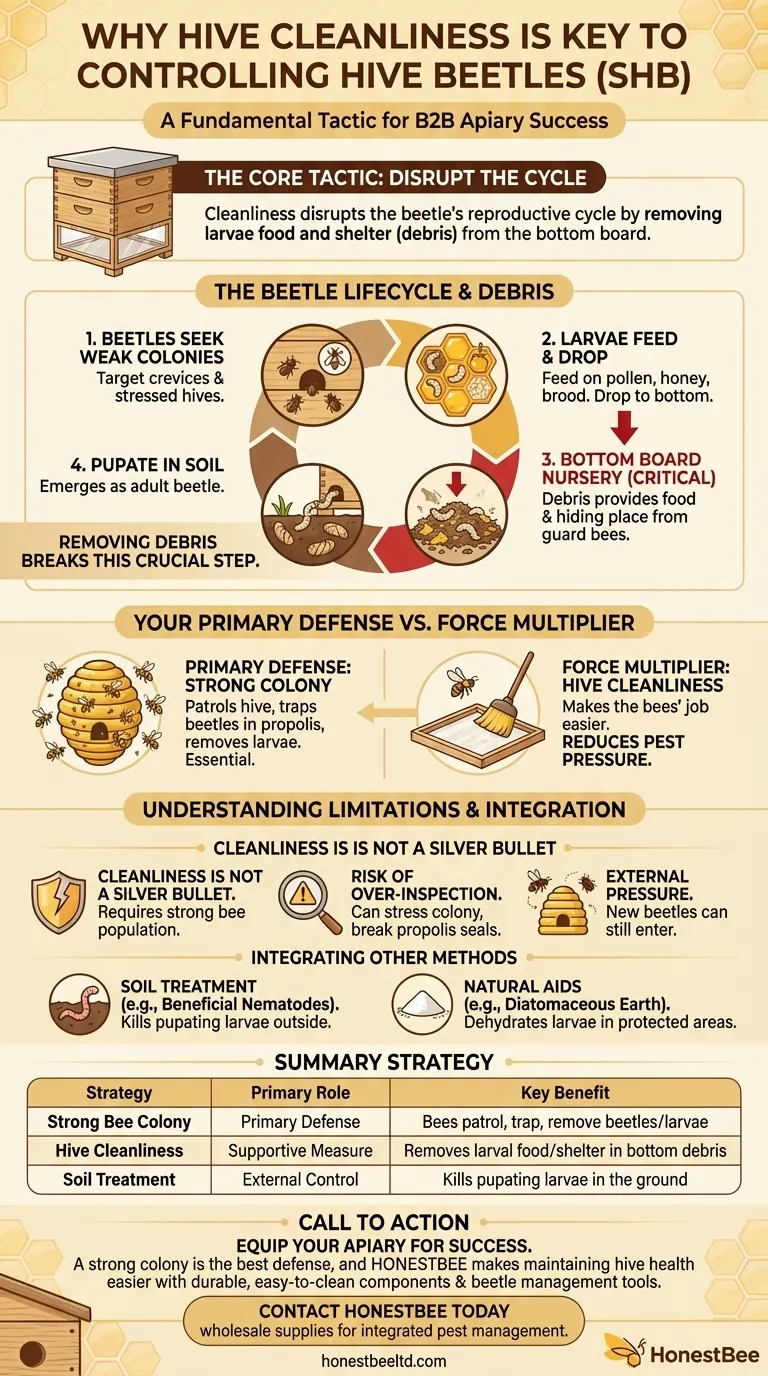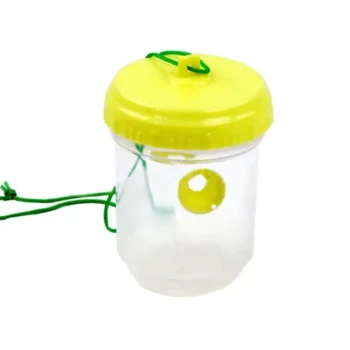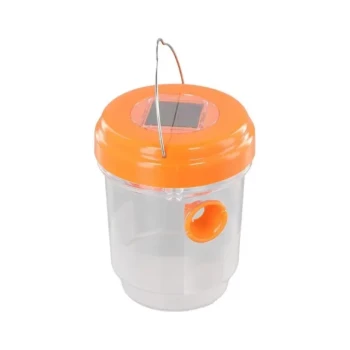Maintaining hive cleanliness is a fundamental tactic in the fight against the Small Hive Beetle (SHB). A clean hive directly disrupts the beetle's reproductive cycle by removing the debris on the bottom board that their larvae use for food and shelter before leaving the hive to pupate in the soil. This simple act of housekeeping makes the hive a far less hospitable environment for beetle populations to establish and grow.
While a clean hive is less attractive to beetles, your primary defense is not sanitation, but a strong, populous bee colony. Cleanliness is a supportive measure that reduces stress on the colony, allowing your bees to more effectively police their own space.

The Beetle Lifecycle: Why Debris Matters
The Beetle's Strategy
Small Hive Beetles seek out weak or stressed colonies where they can lay their eggs. They often target crevices and corners where bees have difficulty patrolling.
The Role of the Bottom Board
Once beetle eggs hatch, the larvae feed on pollen, honey, and bee brood. As they grow, they drop to the bottom of the hive and burrow into the accumulated debris. This "hive trash"—wax cappings, pollen, and dead bees—provides a critical food source and hiding place from guard bees.
Pupation Outside the Hive
After feeding and maturing in the bottom board debris, the larvae crawl out of the hive entrance. They then burrow into the soil within a few feet of the hive to pupate, later emerging as adult beetles ready to re-infest the colony. Removing debris breaks this crucial step in their lifecycle.
Your Colony's Role as the Primary Defense
The Power of a Strong Colony
The single most effective defense against SHB is a robust and populous bee colony. A hive teeming with healthy worker bees has the numbers to patrol every corner of the hive, effectively chasing beetles, trapping them in propolis "jails," and removing their larvae.
How a Weak Colony Fails
In a weak colony, there are not enough bees to guard the available space. This allows beetles to lay eggs unchecked, leading to a rapid and destructive larval infestation that can slime the honey and cause the entire colony to abscond.
Cleanliness as a Force Multiplier
This is where cleanliness becomes so important. By keeping the bottom board clean, you are not replacing the bees' defensive role; you are making their job easier. You remove the primary nursery for beetle larvae inside the hive, reducing the overall pest pressure the colony must manage.
Understanding the Limitations
Cleanliness is Not a Silver Bullet
A perfectly clean hive can still be overrun by beetles if the bee population is too small or weak to defend its territory. Sanitation is a supportive tactic, not a standalone solution.
The Risk of Over-Inspection
While cleaning is important, opening the hive too frequently can stress the colony. Each inspection breaks the propolis seals the bees create as part of their own defense, forcing them to expend energy resealing the hive instead of foraging or raising brood.
External Beetle Pressure
Remember that cleaning only addresses the internal hive environment. If you are in an area with high beetle populations, new beetles will constantly try to enter the hive regardless of how clean it is.
Integrating Other Control Methods
Targeting Larvae in the Soil
Because mature larvae pupate in the soil outside the hive, treating the ground is a highly effective strategy. Beneficial nematodes are microscopic worms that actively hunt and kill SHB pupae in the soil, providing a powerful, chemical-free layer of defense.
Using Other Natural Aids
Other natural remedies can supplement your efforts. Diatomaceous earth can be placed on the bottom board (in a way that bees cannot directly access it) to dehydrate and kill larvae.
Making the Right Choice for Your Apiary
A successful beetle management plan integrates several strategies with a focus on colony health.
- If your primary focus is preventing infestations: Prioritize colony strength above all else through good nutrition, proper mite control, and a strong queen.
- If your primary focus is supporting a struggling hive: Combine regular cleaning with in-hive traps to reduce the immediate beetle load, giving the bees a chance to recover.
- If your primary focus is a long-term, chemical-free strategy: Pair strong colony management with environmental controls like beneficial nematodes in the soil around your hives.
Ultimately, a proactive strategy focused on promoting colony health is your most powerful tool against the Small Hive Beetle.
Summary Table:
| Strategy | Primary Role | Key Benefit |
|---|---|---|
| Strong Bee Colony | Primary Defense | Bees patrol, trap, and remove beetles/larvae |
| Hive Cleanliness | Supportive Measure | Removes larval food/shelter in bottom debris |
| Soil Treatment (e.g., Nematodes) | External Control | Kills pupating larvae in the ground around hives |
Equip your apiary for success against hive beetles. A strong colony is the best defense, and the right equipment from HONESTBEE makes maintaining hive health easier. We supply durable, easy-to-clean hive components and beetle management tools designed for the demands of commercial beekeepers and distributors.
Let us help you build a more resilient operation. Contact HONESTBEE today to discuss wholesale supplies that support your integrated pest management strategy.
Visual Guide

Related Products
- Reusable Clear Small Hive Beetle Traps for Beehives Beetle Trapping Tools
- Removable Washable Hive Beetle Trap Attractants for Small Hive Beetles
- Reusable Aluminium Beetle Trap for Small Hive Beetles Silver Bullet
- Black Plastic Beetle Barn Hive Beetle Trap for Beehives
- Plastic Beetle Blaster Trap Beekeeping Tools and Supplies
People Also Ask
- What is the recommended number of beetle traps per hive? Optimize Your Hive's Beetle Defense
- What tips can help prevent hive beetle infestations? Build Strong Colonies & Master Apiary Hygiene
- What are the advantages of handheld beetle blasters and traps? Simple, Chemical-Free Hive Protection
- How do hive beetle traps work? A Beekeeper's Guide to Non-Chemical Control
- How do Beetle Blasters trap adult beetles? A Simple, Non-Chemical Pest Control Solution



















